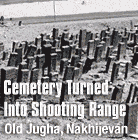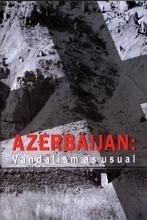Cultural Genocide
Acts and measures undertaken to destroy any nation's or ethnic group's culture are called ‘cultural genocide’. The word ‘Genocide’, coined by Raphael Lemkin, does not only refer to the physical extermination of a national or religious group, but also to its national, spiritual and cultural destruction. The concept of cultural genocide was not included in the 1948 UN Convention on the Prevention and Punishment of the Crime of Genocide.
Many facts prove that along with the massacres and deportation, the Young Turk government was also implemented a premeditated and planed destruction of the material testimonies of the Armenian culture. Realizing the role of the church and Christian faith for the Armenian nation, they intentionally massacred Armenian clergymen, destroyed churches, monasteries, thousands of medieval manuscripts and other church property.
An Arab witness of the Armenian Genocide, Fayez el Hussein, writes in his memoirs "... After the massacres of the Armenians, the government established commissions that were engaged in selling the leftover property. Armenian cultural values were sold at the cheapest prices... Once I went to a church to see how the sale of these things is organized. The doors of the Armenian schools were closed. Turks used the textbooks and scientific books in the market for wrapping cheese, dates, sunflowers... "
In 1912-1913 the Armenian Patriarchy of Istanbul presented an account of the churches and monasteries in Western Armenia (Eastern Anatolia) and in the Ottoman Empire. More than 2300 were accounted for including the early unique Christian monuments of IV-V centuries. But most of them were looted, burned and destroyed during the genocide.
The policy of destruction adopted by the Young Turks with regard to Armenian historical and cultural heritage has been continued in Republican Turkey, where these relics have been viewed as the undesirable witnesses of the Armenian presence.
At the end of 1920s, Turkey began changing the names and titles (toponymy) of certain locations in Western Armenia. Nowadays 90% of the Armenian cities, towns and buildings in Western Armenia have been Turkified. The names of Armenian geographical sites have also been replaced with Turkish names. Devising a systematic method of destruction, hundreds of architectural monuments have been destroyed and all Armenian inscriptions erased.
In 1974 UNESCO stated that after 1923, out of 913 Armenian historical monuments left in Eastern Turkey, 464 have vanished completely, 252 are in ruins, and 197 are in need of complete repair.
Armenian architectural buildings are consistently being demolished with dynamite explosions and used as targets during Turkish military training exercises; the undamaged stones are also used as construction materials. In some rural places, Armenian monasteries and churches serve as stables, stores, clubs and in once case, even a jail. On many occasions the Turkish government converted Armenian churches into mosques.
On June 18, 1987 the Council of Europe adopted a Decree demanding from the Turkish government to pay attention to and take care of the Armenian language, culture and educational system of the Armenian Diaspora living in Turkey, also demanding an appropriate regard to the Armenian historical monuments that are in modern Turkey’s territory.
Cultural genocide against the Armenian heritage on the territory of Turkey continues ...
Following slides present numerous Armenian medieval monuments destroyed during and after the Armenian Genocide.
Horomos Monastery, 10th-11th centuries


- The view of the Horomos Monastery before 1965 and in 1998 (photo S. Karapetian)
Sourb Prkich (Holy Saviour) Church of Ani, 11th century


- The view of the monument in 1910s and in 2000 (photo S. Karapetian)
Bagnayr Monastery, Bagnayr (Ghozluja) Village, 11th-13th centuries


- The view of the Bagnayr Monastery monument before the 1960s and in 2000 (photo S. Karapetian)
Khtzkonk Monastery, 7th-13th centuries


- The view of Monastery complex, early 20th century photo
- The view of Monastery complex after explosion in 1966


- The view of Monastery complex, early 20th century photo
- The part of Monastery complex nowadays (photo S. Karapetian)


- The view of Monastery complex, early 20th century photo
- The view of Monastery complex, in 2000 after explosion in 1966 (photo S. Karapetian)
Tekor Temple, 5th century


- The view of the monument before 1912 and in 2000 (photo S. Karapetian)
St. Hovhannes Church of Bagrevand, 613-619


- The view of the monument before 1966 and in 2000 (photo S. Karapetian)


- Ani, mediaeval Armenian capital, coat of arms of the city in 1910s and 2000, after the Turkish restoration


- Van, region of Aghbak, St. Bartholomew the Apostle Monastery, 1913 and 1980 (photo A. Hakhnazarian)


- Van, Hermitage of Lim Island, North Eastern view, early 1900s and 2004 (photo S. Karapetian)


- Moosh, Sb. Arakelots (of the Holy Apostles) Monastery, 4th-15th centuries, early 1900s and 2000 (photo S. Karapetian)


- Moosh, Sb. Karapet Monastery, 4th-18th centuries, South Western view, early 1900s
- Moosh, village Cankly, on the site of Sb. Karapet Monastery in 2000 (photo S. Karapetian)


- Van, region of Rshtoonik (Gevascd), the Village-Monastery of Narek, South Western view, early 1900s
- Van, region of Rshtoonik (Gevascd), Mosque built on the site of destroyed Narek Monastery in 2004 (photo S. Karapetian)


- Van, village of Koghbantz, ruins of the Monastery of Salnapat, 10th-13th centuries South Western view, early 1900s and 2004 (photo S. Karaperian)


- Van village of Shoushants, site of the Monastery of Karmravor Sb. Asdvadsadsin, early 1900s and 2004 (photo S. Karapetian)


- Van, Varaga Monastery, 10 -11th centuries. Early 1900s and 2004 (photo S. Karapetian)
Source of photographies: RESEARCH ON ARMENIAN ARCHITECTURE www.raa.am
links



